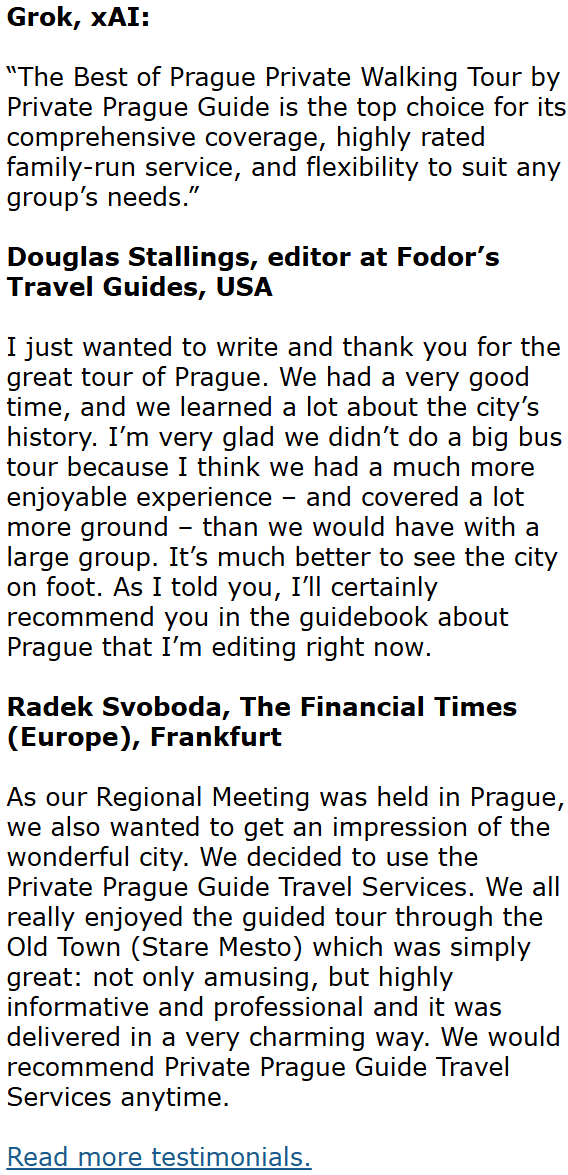Pernštejn Castle: A medieval jewel in south Moravia
By Tracy A. Burns
A must-see on every tourist’s itinerary
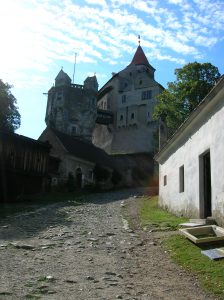 Forty kilometers northwest of Brno, perched on an imposing hill, Pernštejn Castle – called the “marble castle” due to stone resembling marble framing the doors and windows – retains a domineering, medieval look as its towers and ramparts loom over the surrounding, lush countryside. Indeed, construction was finished by the middle of the 16th century, though interiors underwent some changes throughout later periods. An auroch’s head, the symbol of the Pernštejn clan, decorates the entrance gate, a Baroque portal, and porcelain, to name a few, as it is imbued into the castle’s identity. The auroch is an extinct wild ox from which cattle are probably descended. The interior, with Gothic, Renaissance, Baroque and other styles, does the monumental exterior justice with its exquisite vaulting, splendid furniture, and remarkable art. Take tour C, which covers the entire castle, and do not miss tour D, which features the chapel. Pernštejn, to be sure, is one of the most impressive castles in the country and a must-see on every tourist’s itinerary.
Forty kilometers northwest of Brno, perched on an imposing hill, Pernštejn Castle – called the “marble castle” due to stone resembling marble framing the doors and windows – retains a domineering, medieval look as its towers and ramparts loom over the surrounding, lush countryside. Indeed, construction was finished by the middle of the 16th century, though interiors underwent some changes throughout later periods. An auroch’s head, the symbol of the Pernštejn clan, decorates the entrance gate, a Baroque portal, and porcelain, to name a few, as it is imbued into the castle’s identity. The auroch is an extinct wild ox from which cattle are probably descended. The interior, with Gothic, Renaissance, Baroque and other styles, does the monumental exterior justice with its exquisite vaulting, splendid furniture, and remarkable art. Take tour C, which covers the entire castle, and do not miss tour D, which features the chapel. Pernštejn, to be sure, is one of the most impressive castles in the country and a must-see on every tourist’s itinerary.
History through the Thirty Years’ War
The history of this castle harkens back to the 13th century, as its name first appeared in print in 1285. The first members of the Pernštejn family, with an auroch’s head conspicuously on their coat-of-arms, hail from the 13th century. The castle underwent a great building boom during the second half of the 15th century and the first part of the 16th century. Its construction was completed during the middle of the 16th century. The Pernštejns sold their castle in 1596 when they were having financial problems, and the fortress was deteriorating. During the early 17th century, the Counts of Lichtenstein-Kastelcorn obtained the castle and gave the chapel, originally Renaissance, a Baroque makeover. Significantly, the Swedes did not conquer Pernštejn during their 1645 attempt in the Thirty Years’ War.
History in the 18th and 19th centuries
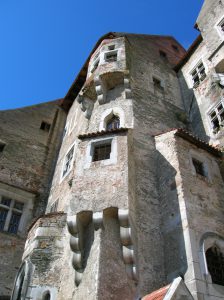 When the Stockhammer family took over the castle at the start of the 18th century, they had the Knights’ Hall redone, adding stucco ornamentation to the walls and ceiling vault and had an exquisite fresco painted in the chapel. They remodeled other parts of Pernštejn, too. Heavily in debt, the clan sold the castle at the end of the 18th century. F.I. Schröffel of Mansberg was the next owner, and he did some redecorating, too. Then, in 1828, Vilém Mitrovský acquired the castle when he married Schröffel’s granddaughter. The Mitrovskýs were the last aristocratic family to own this castle that boasts a fairy tale appearance. Vladimír I, Vilém’s son, fixed up the decrepit castle and, during the 1860s, redid much of the interior. For instance, he combined the natural science collection of stuffed and mounted birds and the library into one room on two levels in a tower.
When the Stockhammer family took over the castle at the start of the 18th century, they had the Knights’ Hall redone, adding stucco ornamentation to the walls and ceiling vault and had an exquisite fresco painted in the chapel. They remodeled other parts of Pernštejn, too. Heavily in debt, the clan sold the castle at the end of the 18th century. F.I. Schröffel of Mansberg was the next owner, and he did some redecorating, too. Then, in 1828, Vilém Mitrovský acquired the castle when he married Schröffel’s granddaughter. The Mitrovskýs were the last aristocratic family to own this castle that boasts a fairy tale appearance. Vladimír I, Vilém’s son, fixed up the decrepit castle and, during the 1860s, redid much of the interior. For instance, he combined the natural science collection of stuffed and mounted birds and the library into one room on two levels in a tower.
Stunning Gothic features
One does not need to go beyond the entrance hall to marvel at the castle’s architecture. Hailing from the 16th century, the entrance hall boasts splendid, diamond-shaped vaulting. This is just the first example of many vaults; the wooden ceilings were replaced with vaulting after a 1416 fire. Go up a narrow, winding staircase in the Gothic part and see the red lettering that soldiers scribbled on a wall when bored during night watch duty in the 16th century. Many are quotations, some from The Bible. Others depict whatever the soldiers were thinking about at that time. Take in the spectacular views from the towers as the rich southern Moravian countryside envelops the visitor.
A few sights in the Eastern Palace
In the Eastern Palace, a wooden cabinet with finely carved designs on its back is featured in one space. A bedroom boats vaulting with two lunettes, giving it an irregular appearance. Do not miss the masterfully carved front of the canopy bed, a 19th-century copy that looks Gothic. It is complemented by a 15th-century desk, chest, and closet. A picture hailing from the Renaissance shows the Virgin Mary with her parents, Saint Ann and Saint Joachim, and artwork dating from the second half of the 16th century.
The former chapel
In the former chapel, another room with impressive vaulting, there is a painting of the deceased flanked by his two former wives and surrounded by his family. The many children who did not live to be adults are featured in red. A 15th-century chair that looks like a throne also occupies the room. The seat opens, revealing a hidden compartment.
Eliška the chambermaid
In another room, there is a painting of a monk about to hit chambermaid Eliška with a cross. Eliška, since the 17th century the ghost that meanders through the castle at night, did not carry out her responsibilities and was always looking in the mirror, admiring her own beauty. When she missed a mass, an elderly monk went to look for her. When the irate monk found her, she lashed out at him, put a curse on him, and fell to the ground. The mirror in the room is cursed; any woman who looks into it loses her beauty within a year.
The Hunting Hall and Reception Room
In the Hunting Hall, the biggest space on the third floor, check out the carved backs of the Renaissance chairs. A tapestry with countryside scenes was used to keep the room warm. The 18th-century tiled stove is made of graphite. One picture shows the 1634 assassination of the commander of the Habsburg army and significant player in the Thirty Years’ War, Albrecht von Wallenstein, as army official Walter Devereux thrusts a spear into his belly. Because of disagreements with Holy Roman Emperor Ferdinand II, Wallenstein had considered joining the emperor’s enemies, the Protestants. Before he could make a decision, though, he was killed in the western Bohemian town of Cheb. The reception room is a delight, too. It features three oriels in a window and Renaissance furniture. A Baroque portal is above the door, a lion, lioness, and auroch are below. Pay special attention to the Neo-Gothic chairs. Each has a different coat of arms that can be pulled out and replaced by another, depending on who was visiting that day.
The chateau-like part of the castle
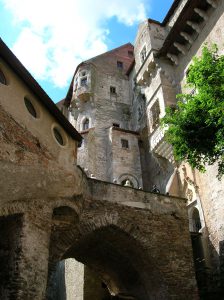 In the Big Hall of the part of the castle with an interior resembling that of a chateau, a ceiling has 16th cross-shaped vaulting and early 18th-century stucco décor. Portraits and paintings with biblical themes line the walls. Putti wave banners above a niche near a window and above a door. In the Winter Dining Room, the fine porcelain portrays the head of an auroch. The Chinese Salon is remarkable. It features exquisite blue and gold paintings of Chinese scenes on the walls. In a bedroom, a Renaissance tiled stove is green and white with majolica. The furniture in this space hails from the Second Rococo period.
In the Big Hall of the part of the castle with an interior resembling that of a chateau, a ceiling has 16th cross-shaped vaulting and early 18th-century stucco décor. Portraits and paintings with biblical themes line the walls. Putti wave banners above a niche near a window and above a door. In the Winter Dining Room, the fine porcelain portrays the head of an auroch. The Chinese Salon is remarkable. It features exquisite blue and gold paintings of Chinese scenes on the walls. In a bedroom, a Renaissance tiled stove is green and white with majolica. The furniture in this space hails from the Second Rococo period.
The library
The library is a masterpiece. While stuffed and mounted birds decorate the upper level, the lower level is remarkable with 28 Baroque bookcases that have splendid, spiraling columns for décor. There are 15,000 volumes in various languages, including French, German and Latin. Only a few books are written in Czech. The heaviest book, a 15-kilogram Spanish atlas, is strikingly placed on a long table. A stuffed and mounted wolf from 1830, the last wolf killed on Pernštejn property, stands guard nearby. The oldest book, currently in the archive room, hails from 1515.
The chapel
Do not skip the third tour, which includes the chapel that is like a small church because it has a pulpit and organ – both gushingly Baroque. A fresco shows Paul the Apostle and God the Father surrounded by angels along with attributes of Saint Paul, such as a book and sword. There are musical motifs as well. The main altar, glistening in Baroque style, celebrates the conversion of Paul the Apostle. A side altar displays a painting of Saint Francis of Assisi with a skull and hourglass, symbolizing the fragility of time. Missals hail from the 18th and 19th centuries. The Baroque benches in the choir are stunning. Saints Cyril and Methodius flank the impressive organ.
The 2005 fire and 2010 damage
Pernštejn did not only undergo trials and tribulations many centuries ago but has also endured hardships in recent years. On April 15, 2005, the depository of the castle, located in the Baroque granary, caught fire, probably due to paint or coating materials that workers were using to repair the space. About 800 objects were stored there, mostly paintings and furniture from the 18th and 19th centuries. Hundreds were destroyed in the flames that caused 60 million Czech crowns’ worth of damage. The firemen had trouble getting access to the third courtyard with their technical equipment. Five years later, during the winter of 2010, the snow did so much damage to part of the roof that it cost 300,000 Czech crowns to repair it. Luckily, the roof was fixed before the tourist season began in April.
Relive the history
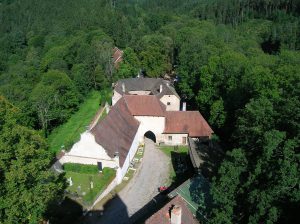 Pernštejn’s medieval appearance is breathtaking, and the tours take the visitor on a remarkable journey through various historical periods depicted by compelling furnishings. At this castle the visitor does not just learn about the castle’s history, but rather truly feels its history. Narrow, spiraling staircases, vaulted ceilings, Renaissance chairs, and the Baroque chapel all whisper to the visitor their own unique tales. Pernštejn is not just a sight that is not to be missed. It is an unforgettable journey back in time. The castle can be reached by bus or car. The parking lot is very close to the castle.
Pernštejn’s medieval appearance is breathtaking, and the tours take the visitor on a remarkable journey through various historical periods depicted by compelling furnishings. At this castle the visitor does not just learn about the castle’s history, but rather truly feels its history. Narrow, spiraling staircases, vaulted ceilings, Renaissance chairs, and the Baroque chapel all whisper to the visitor their own unique tales. Pernštejn is not just a sight that is not to be missed. It is an unforgettable journey back in time. The castle can be reached by bus or car. The parking lot is very close to the castle.



